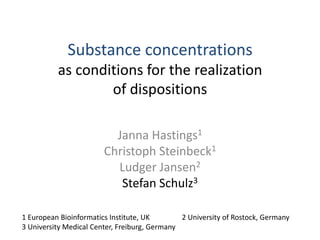
Substance concentrations as conditions for the realization of dispositions
- 1. Substance concentrationsas conditions for the realizationof dispositions Janna Hastings1 Christoph Steinbeck1 Ludger Jansen2 Stefan Schulz3 1 European Bioinformatics Institute, UK 2 University of Rostock, Germany 3 University Medical Center, Freiburg, Germany
- 2. Problem Ontologies make statements that are universally true Dispositional properties specifywhat might occurunder the right circumstances 7/5/2010 2 Bio-ontologies 2010: Substance concentrations as conditions for the realization of dispositions
- 3. Dispositions, functions Increasingly important in biomedical ontologies as they allow functionally similar groupings for entities that are constitutionally dissimilar Realization: the process in which the disposition is ‘fulfilled’ Realization is conditional 7/5/2010 3 Bio-ontologies 2010: Substance concentrations as conditions for the realization of dispositions
- 4. Small molecule bioactivity Drugs and metabolites: small molecules active in biological contexts 7/5/2010 4 Oxygen transport in the bodydepends on the disposition of hemeto bind oxygen and the disposition to release oxygen depending on the surrounding concentration Image credit: gassama.myweb.uga.edu/ Bio-ontologies 2010: Substance concentrations as conditions for the realization of dispositions
- 5. Concentrations Concentrations are system propertiesa concentration is always a concentration of something in something 7/5/2010 e.g. the concentration of alcohol in bloodhere shown in the Blood Alcohol Chart Image credit: http://www.boat-ed.com/images/drawings/ Bio-ontologies 2010: Substance concentrations as conditions for the realization of dispositions 5
- 6. Active concentrations Consider aspirin as treatment for a headache Too few individual molecules will have no effectToo many tablets will have unpleasant additional effects 7/5/2010 Bio-ontologies 2010: Substance concentrations as conditions for the realization of dispositions 6 Image credit: tell.fll.purdue.edu
- 7. Conditions in biomedical ontologies Conditions for dispositional property realization, such as concentrations for active molecules, are seldom modelled explicitly in biomedical ontologies Such models are difficult to express in OWL binary relations 7/5/2010 Bio-ontologies 2010: Substance concentrations as conditions for the realization of dispositions 7
- 8. Dispositions are realized in processes 7/5/2010 Bio-ontologies 2010: Substance concentrations as conditions for the realization of dispositions 8
- 9. Model: Dispositions Consider the case of aspirin, which has the disposition to treat pain We can formulate this as: PortionOfAspirin ⊑ ∃ bearerOf.(Disposition ⊓ ∀ hasRealization.(Treating ⊓ ∃ hasParticipant.Pain)) 7/5/2010 Bio-ontologies 2010: Substance concentrations as conditions for the realization of dispositions 9
- 10. Concentrations are properties of mixtures 7/5/2010 Bio-ontologies 2010: Substance concentrations as conditions for the realization of dispositions 10
- 11. Model: Concentrations Consider a mixture of 10g water with 10g glucose We have three entities of interest the water/glucose mixture wgmix, the water fraction wcoll, i.e. the collection of all water molecules, and the glucose fraction gcoll, i.e. the collection of all glucose molecules. 7/5/2010 Bio-ontologies 2010: Substance concentrations as conditions for the realization of dispositions 11
- 12. Model: Concentrations The collection of glucose molecules in the water: G ⊑ EntireMolecule Gcoll ⊑ HomogeneousCollection Gcoll ≣ ∃ hasGranularPart.G ⊓ ∀ hasGranularPart.G A mixture has several components: WGmix ⊑ Mixture WGmix ⊑ =1 hasComponent.Gcoll ⊓ =1 hasComponent.Wcoll 7/5/2010 Bio-ontologies 2010: Substance concentrations as conditions for the realization of dispositions 12
- 13. Model: Concentrations A concentration can be ascribed to a collection iff this collection is a component of a mixture ∃ bearerOf.Concentration ≡ Homogeneous collection ⊓ ∃ componentOf.Mixture Concentration ⊑ ∃ inheresIn. (HomogeneousCollection ⊓ ∃ componentOf.Mixture) Finally, we can state that BloodGlucoseVolumeConcentration ≡ VolumeConcentration ⊓ ∃ inheresIn. (PortionOfGlucose ⊓ ∃ componentOf.PortionOfBlood) 7/5/2010 Bio-ontologies 2010: Substance concentrations as conditions for the realization of dispositions 13
- 14. The process, which realizes the disposition of a collection of molecules, can only occur when a sufficient concentration is available 7/5/2010 Bio-ontologies 2010: Substance concentrations as conditions for the realization of dispositions 14
- 15. Conditions for realization How do we link the relevant conditions to the realization of dispositions? As a trigger: PortionOfAspirin ⊑ ∃ bearerOf.(Disposition ⊓ ∀ hasRealization.(Treating ⊓ ∃ hasParticipant.Pain ⊓ ∃ hasTrigger. SufficientConcentration)) where, of course, SufficientConcentration⊑ BloodAspirinVolumeConcentration. 7/5/2010 Bio-ontologies 2010: Substance concentrations as conditions for the realization of dispositions 15
- 16. Conclusions Dispositional properties are fundamental to functional classification in Bio-ontologies Dispositional properties are defined in terms of their realization, but often realization also depends on triggering conditions One such triggering condition is the concentration of bioactive substances in the body 7/5/2010 Bio-ontologies 2010: Substance concentrations as conditions for the realization of dispositions 16
- 17. Acknowledgements Funding BBSRC, grant agreement number BB/G022747/1 within the "Bioinformatics and biological resources" fund; and the DFG, grant agreement number JA 1904/2-1, SCHU 2515/1-1 GoodOD (Good Ontology Design).
